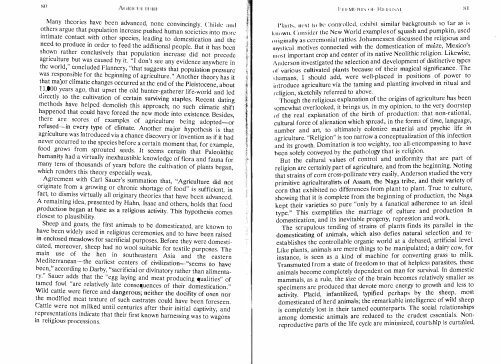CONTENTS - ouroboros ponderosa
CONTENTS - ouroboros ponderosa
CONTENTS - ouroboros ponderosa
Create successful ePaper yourself
Turn your PDF publications into a flip-book with our unique Google optimized e-Paper software.
SII<br />
Many thcories havc been advanced, none convincingly. Childe alld<br />
others argue that population increase pushed human societies into more<br />
intimate contact with other species, leading to domcstication and the<br />
need to produce in order to feed the additional people. But it has been<br />
sho . wn rather conclusively that population increase did not precede<br />
agrrculture but was caused by it. "I don't see any evidence anywhere in<br />
thc world," ?oncluded Flannery, "that suggests that population pressure<br />
was responSIble for the beginning of agriculture." Another theory has it<br />
that major clImatIc changcs occurred at thc end of the Pleistocene, about<br />
11,000 years ago, that upset the old hunter-gatherer life-world and led<br />
dlrcctly to the cultivation of certain surviving staples. Recent dating<br />
methods have helped demolish this approach; no such climatic shift<br />
happened that could have forced the new mode into existence. Besides,<br />
there are scores of examples of agriculture being adopted-or<br />
ret used-In evcry type of climate. Another major hypothcsis is that<br />
agnculture was Introduced via a chance discovery or invention as if it had<br />
never occurred to the species before a certain moment that, for example,<br />
food grows from sprouted seeds. It seems certain that Paleolithic<br />
humanity had a virtually inexhaustible knowledge of flora and fauna for<br />
many tens of thousands of years before the cultivation of plants began<br />
which renders this theory especially weak.<br />
Agreemenl with Carl Sauer's summation that, "Agriculture did not<br />
ongmate trom a growing or chronic shortage of fo od" is sufficient in<br />
fact, to dismiss virtually all originary theories that have been advaned.<br />
A remaining idea, presented by Hahn, Isaac and others, holds that food<br />
production began at base as a religious activity. This hypothesis comes<br />
closest to plausibility.<br />
Sheep and goats, the tlrst animals to bc domesticated, are known to<br />
have been widely used in religious ceremonies, and to have been raised<br />
In enclosed meadows lor sacrificial purposes. Before they werc domesti<br />
catd, moreover, shecp had no wool suitablc for textile purposes. The<br />
mam use of the hen in southeastern Asia and the eastern<br />
Mediterranean-the earliest centers of eivilization-"seems to have<br />
been," according to Darby, "sacrificial or divinatory rather than alimenta<br />
ry." Sauer adds that the "egg laying and meat producing qualities" of<br />
tamcd fowl "arc relatively late consequences of their domestication "<br />
Wild cattle were fierce and dangerous; neither the docility of oxen nr<br />
the modltled meat texture of such castrates could have been foreseen.<br />
Cattle were not milked until centuries after their initial captivity, and<br />
representations mdleatc that their first known harnessing was to wagons<br />
In relIgIOUS processions.<br />
'<br />
I'I I'MI'HIS • II· 1{I'J' I IS:\ 1<br />
Planls. lI('xt to Ill: contrulled) exhihit. similar backgrounds so ':ar as is<br />
1l()WIl. (\lIlsidn the New World examples of squash and pumpkrn, uscd<br />
originally as ceremonial rattles. Johannessen discussed the rehglous . "n?<br />
lIlystical motives connected with the domestication of Ize, MeXICO s<br />
lIlost important crop and center of its native Neolithic relIglo . n. LIkeWIse,<br />
Anderson investigated the selection and developmnt of dlshnctIve types<br />
"I' various cultivated plants because of their magIcal slgnrflcance. The<br />
shamans, I should add, were well-placed in positions of powcr to<br />
introduce agriculture via the taming and planting involved m ntual and<br />
religion, sketchily referred to above. .<br />
.<br />
. . '<br />
Though the religious explanatIon of the ongIns of agnclllture has been<br />
somcwhat overlooked, it brings us, In my oplOlon, to the very doorstep<br />
of the real explanation of the birth of production: that non-ratIonal,<br />
cultural force of alienation which spread , in the forms of hme, language,<br />
number and art, to ultimately colonize material and psychIC lIfe III<br />
agriculture. "Religion" is too narrow a conceptualization of thIS lllfectlon<br />
and its growth. Domination is too weighty, too all : encompassmg to have<br />
hecn solely conveyed by thc pathology that IS relIgIon.<br />
But the cultural values of control and uniformity that are part of<br />
religion are certainly part of agriculture, and from the heginning. Noting<br />
that strains of corn cross-pollinate very eaSIly, Anderson studled the very<br />
primitive agriculturalists of Assam, the Naga tribe, and theIr varIety of<br />
corn that exhibited no differences from plant to plant. True to culture,<br />
showing that it is complete from the beginning of production, the Naga<br />
kept their varieties so pure "only by a fanatical adherence to a Ideal<br />
type." This exemplifies the marnage of cllltur and productIOn In<br />
domestication and its inevitable progeny, repressIon and work.<br />
The scrupulous tending of strains of plants finds its parallel in the<br />
domesticating of animals, which also defies natural selechon and re<br />
establishes the controllable organic world at a debased, artIfICIal level.<br />
Like plants, animals are mere things to be manipulate . d; a dairy cow, for<br />
instance, is seen as a kind of machine for convertIng grass to milk.<br />
Transmuted from a state of freedom to that of helpless paraSItes, these<br />
animals become completely dependcnt on man for survival. In domestIc<br />
mammals, as a rule, the size of the brain becomes relatively smaller as<br />
specimens are produced that devote more eneq,'Y to growth and less to<br />
activity. Placid, infantilized, typified perhaps by the sheep, most<br />
domesticated of herd animals; the remarkable mtelligence of WIld sheep<br />
is completely lost in their tamed counterparts. The social relationships<br />
among domestic animals are reduced to the crudest essenllals. Non<br />
reproductive parts of the life cycle are minimized, courtship IS curtaIled,<br />
.<br />
SI<br />
.






